|
|
|
Sort Order |
|
|
|
Items / Page
|
|
|
|
|
|
|
| Srl | Item |
| 1 |
ID:
119165
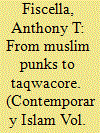

|
|
|
|
|
| Publication |
2012.
|
| Summary/Abstract |
This article is an attempt to provide a very rough outline of the historical interaction between punk rock and the Muslim world. For the most part, the antinomian youth culture of punk rock was relatively slow to reach Muslims outside of Europe and North America. When it did reach Muslim youth (from Europe to Asia to the Middle East), it tended to initially manifest in secular and antireligious terms. Yet by the 1990s, some examples of punk arose that claimed a Muslim identity, and by the year 2005, a scene called "taqwacore" developed. This new scene embraced both religious and nonreligious Muslim punks and others who did not self-identify as Muslim in any way. It's been called "punk Islam" and has made a place for itself on the fringes of the punk scene and the Muslim world. Finally, this article briefly addresses some ways in which taqwacore can be seen as a theological development within Islam.
|
|
|
|
|
|
|
|
|
|
|
|
|
|
|
|
| 2 |
ID:
073300
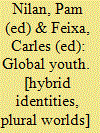

|
|
|
|
|
| Publication |
London, Routledge, 2006.
|
| Description |
xii, 218p.
|
| Standard Number |
041537071X
|
|
|
|
|
|
|
|
|
|
|
|
Copies: C:1/I:0,R:0,Q:0
Circulation
| Accession# | Call# | Current Location | Status | Policy | Location |
| 051578 | 305.235090511/NIL 051578 | Main | On Shelf | General | |
|
|
|
|
| 3 |
ID:
139244
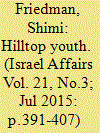

|
|
|
|
|
| Summary/Abstract |
In the first decade of this century, a new social group, popularly called the ‘hilltop youth’, came to the attention of Israeli society. This group consisted of a small number of young people who took part in aggressive political actions including illegal settlement endeavours throughout Judea and Samaria. Before their arrival at the various wilderness outposts, these youth had not developed any political outlook in regard to Jewish settlement in these areas; it was only during their period of habitation did they tend to adopt and utilize views informed by ideological and cultural extremism. The manifestation of this socio-political phenomenon will be analysed from sociological and anthropological perspectives in order to shed light on social aspects of Israeli society, as well as to elucidate frequently unclear political and policy implications in the larger Middle Eastern context. In addition, this article describes the significance of a youth subculture that has emerged in this frontier political space, and which has often been cast in criminological terms. To buttress the claims advanced in this study, a psychological-sociological approach is also employed.
|
|
|
|
|
|
|
|
|
|
|
|
|
|
|
|
| 4 |
ID:
182357
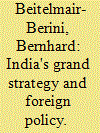

|
|
|
|
|
| Publication |
Oxon, Routledge, 2022.
|
| Description |
xii, 200p.:figureshbk
|
| Series |
Routledge Advances in South Asia Studies; 42
|
| Standard Number |
9780367553449
|
|
|
|
|
|
|
|
|
|
|
|
Copies: C:1/I:0,R:1,Q:0
Circulation
| Accession# | Call# | Current Location | Status | Policy | Location |
| 060105 | 306.20954/BEI 060105 | Main | On Shelf | Reference books | |
|
|
|
|
| 5 |
ID:
175735
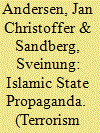

|
|
|
|
|
| Summary/Abstract |
The Islamic State (IS) has become notorious for violent, brutal actions and the presentation of these actions in social and mainstream media. Excessive violence creates a spectacle for the news media. However, IS propaganda also emphasizes its role in state building and its engagement in social and welfare work. This twofold propaganda enables the mobilization of different audiences, but it also sends conflicting messages about the organization. In this article, we study the e-magazine Dabiq, emphasizing its methods of gaining support and attempting to recruit Western participants to violent jihadism. We use theories of social movement and subculture to reveal some of the underlying tensions in IS’s communicative strategies. The analysis first identifies how IS frames its propaganda, attempting to mobilize widespread support. Then, it highlights another dimension of IS’s rhetoric: provocations, the creation of sensationalist spectacles of violence and links to excitement seeking, stardom, and popular culture. We conclude that combining general anti-Western rhetoric and religious imagery with extraordinary depictions of violence has been both a strength and flaw in the organization’s propaganda.
|
|
|
|
|
|
|
|
|
|
|
|
|
|
|
|
| 6 |
ID:
109141


|
|
|
|
|
| Publication |
2011.
|
| Summary/Abstract |
My aim in this article is to extend Marc Sageman's seminal research on Al Qaeda by re-articulating it through the prism of Albert Cohen's theory of delinquent subcultures, an approach which came to prominence in Criminology in the 1960s, but has since then been largely eclipsed by other approaches in that field. Drawing on Sageman's findings and observations, I suggest that Al Qaeda-affiliated or -inspired groups in the West can be best understood as a collective response or "solution" to the strains encountered by the members of these groups, and that these strains are imposed on them by the circumstances in which they find themselves. My broader aim is to show that although Criminology, with a few exceptions, ignores the subject of terrorism, terrorism studies can appreciably benefit from an engagement with Criminology as a source of theoretical inspiration.
|
|
|
|
|
|
|
|
|
|
|
|
|
|
|
|
| 7 |
ID:
169934
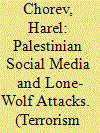

|
|
|
|
|
| Summary/Abstract |
This article examines the impact of social media on the wave of Palestinian lone-wolf attacks against Israelis from October 2015 through September 2016. My principal argument is that social media played an important role in shaping the identity, perceptions, and behavioral patterns of dozens of assailants, and was key in creating the dynamic that ultimately characterized both the spreading of the idea of lone-wolf attacks and its execution. Social media reflected reality on the ground while simultaneously nourishing, amplifying, and escalating the situation by providing a platform for the emergence of new sources of authority, including an online subculture with distinct codes and pseudo-ritual patterns to support assailants. Social media also contributed substantially to shaping the contagious character of the attacks, and their capacity to persist without direct organizational guidance, following a typical epidemiological dynamic of spread, containment, and preservation.
|
|
|
|
|
|
|
|
|
|
|
|
|
|
|
|
| 8 |
ID:
138773
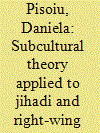

|
|
|
|
|
| Summary/Abstract |
This article assesses the applicability of subcultural theories to individual cases of jihadi and Right-wing radicalization in Germany, with a focus on the individual initial situation and motivation for involvement. Within an overall qualitative research design, the article tests deviance/strain and Centre for Contemporary Cultural Studies (CCCS) subcultural theories against four jihadi and three Right-wing extremist cases. The findings show little support for the strain-based status frustration hypothesis, but confirm the illegitimate opportunity structure thesis; modified versions of the CCCS’ resistance, bricolage, and homology concepts; as well as some of the postmodern approaches to agency and cultural cross-fertilization. The jihadi and Right-wing radicals examined here are assertive and purposive agents, strategically using the rich cultural arsenal available in the mainstream and/or other subcultures, while at the same time being themselves influenced by contemporary mainstream preferences of style. The article discusses the implications of these findings for radicalization research and specific subcultural approaches. It argues for a greater focus on both individual agency and the (sub-)cultural context for an improved understanding of individual involvement in political violence.
|
|
|
|
|
|
|
|
|
|
|
|
|
|
|
|
|
|
|
|
|